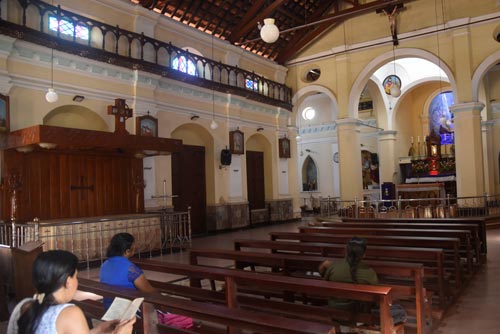A Lenten journey of faith & hope

Veneration at St. Peter's Church, Negombo. Pix by Akila Jayawardena
Solace, succour and gratitude for favours granted are tangible as men, women and children walk past a glass casket bearing the hallowed statue of the crucified Christ amidst the chanting of the rosary interspersed with the hauntingly moving hymn ‘Namo Mariyane’ in honour of Mother Mary.
It is on a Friday just before Christians commemorate Good Friday (on March 29) and Easter Sunday today that we are at St. Peter’s Church, Negombo, having heard of the haaskam (miracles) that have been bestowed on numerous people including those of other religions.
Some weep in thankfulness for the divine favours granted, while others shed a tear in anticipation of the easing of sorrow, while pressing photographs of loved ones against the glass and looking intently at Christ’s bloodied face.
“We are praying for the healing of our son,” sighs a woman whose eyes well up with tears, while her husband carries a boy of about 10 who cannot walk, but gives us a lopsided grin as he says he is Kevin.
A grandmother-granddaughter duo, the older woman a Buddhist, was there to say thank you for helping all her family members to go abroad for employment. The grandmother, Sriyawathi Silva, from Andiambalama clutches several colour photographs.

The place of rest (on the left) for the statue when at the Duwa church
Sharmalee Fernando from Periyamulla believes that there have been abundant blessings on her family over a long period of time.
Then there was Joseph, the weather-beaten fisherman from Mankuliya, who held up his hand to show proof of how his faith paid off. The doctors were supposed to amputate four of his fingers but his fervent prayer at the statue saved three fingers for him.
“Mata adenawa suruwama langa (I cry at the statue),” he says, without embarrassment or hesitation, adding “mama Jesuta thama magey karadara kiwwe (It is to Jesus that I told my troubles)”.
There is much faith, history and sentimental value for this statue, says the Parish Priest of St. Peter’s Church, Fr. Jayantha Wickremasinghe, as he explains that such feelings are passed down from generation to generation.
He says that the statue is only open for public veneration every Friday during Lent and only on the first Friday of the month at other times. Those who are in charge of the statue wear gloves and also hold dum (incense), whenever it is opened to the public.
The history of the statue is as fascinating as the tales people tell us. The beloved statue has two homes – for one year it is kept at Negombo’s St. Peter’s Church and for two years at Duwa’s Church of Our Lady of Good Voyage.
This year it was the turn of St. Peter’s Church and the 3-4km journey from Duwa to Negombo had taken place on February 11 as Christians in the area were preparing for Lent, the period when they shadow the footsteps of Christ who spent 40 days fasting in the desert before beginning His public ministry.
Starting on Ash Wednesday (February 14), it is a period of prayer, fasting and almsgiving culminating in the commemoration of Christ’s crucifixion in all its torture and horror on Good Friday ……and then hope with His resurrection on Easter Sunday.
Hundreds had joined the procession bearing the statue, with lots of people carrying it on their shoulders, while many more knelt on the tarred road or crept under the casket, while showering flowers when it wended its way from the blue sea-fronted Duwa church to St. Peter’s Church in the heart of the town.
Numerous were the stops en route – like a relay with different parishes carrying their beloved Christ – from Duwa church to Duwa junction, across the bridge to Mankuliya, Munnakkaraya, Grand Street and finally to busy Market Handiya where stands St. Peter’s Church.
The history of the statue is shrouded in the dim mists of time and it is an elder of the Duwa Church, Eden Mel, who peeps back at how Duwa was and still is famous for its Passion Play (the Easter pageant which is a dramatic presentation depicting the Passion of Jesus Christ: his trial, suffering and death). In the early days, rookada (puppets) had been used.
With much links between India and then Ceylon and fishing boats going back and forth, three brothers in the Duwa area, Mihindukulasuriya Juan Fernando, Mihindukulasuriya Domingo Fernando and Mihindukulasuriya Peduru Fernando, had decided to commission sculptor Jacome Maestri in Cochin to make a beautiful statue of the crucified Christ.
In their enthusiasm to get it back for the Passion Play in 1838, against the advice of the sculptor that the paint was still fresh and wet, they had gently wrapped the statue in a veil for the journey. On coming ashore in Duwa, the three brothers had found to their dismay that the paint had in fact got smeared and smudged.

Hand-embossed veil and the grinding stone
When they requested Maestri to come here post-haste to touch up the damage, he had been unable to do so as he was too old, but assigned his best golaya to do the needful. The golaya had requested that 72 gold sovereigns would be needed for him to get the gold powder by scraping it on a grinding stone to blend with the paint to restore the statue to its former glory.
“Ran ura gala arang thibbey,” says Eden, pointing out that nearly half of the sovereigns had been discarded when the padama (mixture) was not right.
He asks: “Have you looked at the statue closely. It is the gold-paint blend that gives the statue the real-life quality of the colour and complexion of a human being.”
While the palanquin in which the statue had been brought to this country from Cochin is shown to us in a room at the rear of the Duwa church, the veil, grinding stone and also a pillow-case which covered the pillow on which lay Christ’s head during the voyage are in the home of a staunch devotee close to the church.
………And so, re-living the agony of Christ by looking at this statue which has taken centre-stage on Good Friday, the faithful will rejoice over His resurrection today. For all of them, the statue is the embodiment of Christ who died for His precious people but rose from the dead to be among them even after 2,024 years have passed.
Searching for an ideal partner? Find your soul mate on Hitad.lk, Sri Lanka's favourite marriage proposals page. With Hitad.lk matrimonial advertisements you have access to thousands of ads from potential suitors who are looking for someone just like you.


